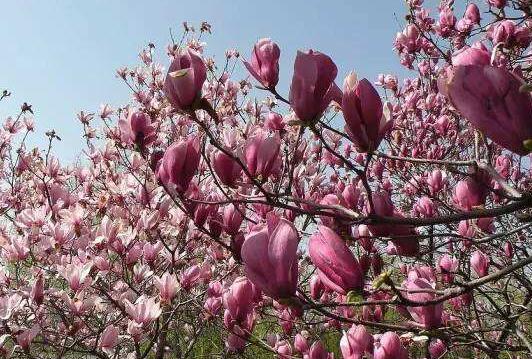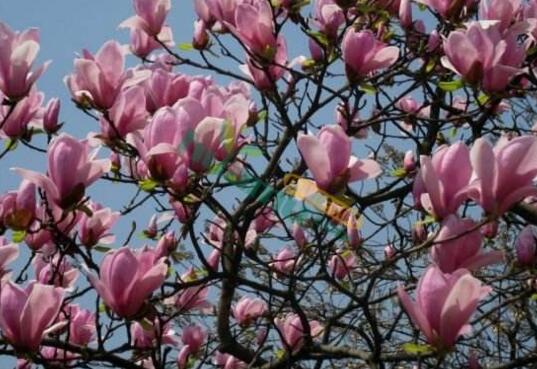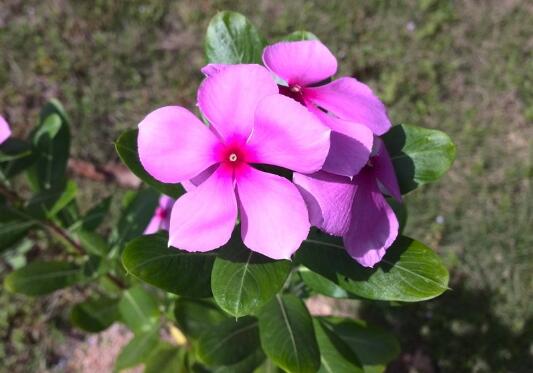How to prune Magnolia Magnolia, pruning method / after blossom / pruning before sprouting
When many plants are planted, they need to be pruned in time to ensure that their plant shape is more beautiful, but Magnolia magnolia is a unique plant, pruning it may hurt flower buds, so we must pay attention to the method. So how to prune Magnolia? The editor will tell you the answer.
How to prune purple magnolia

Usually, the purple magnolia tree is not short cut, because it may cut the flower bud, affecting its normal flowering, only when necessary for proper pruning, then how to prune the purple magnolia? Let's learn more about the time and method of pruning.
When will the purple magnolia be trimmed
The time of pruning is generally chosen in three time periods, namely, after flower fade, before a large number of sprouts, and when diseases and insect pests appear. At other times, there is less pruning, generally unnecessary, purple magnolia trees do not need pruning, and this will not affect the efficacy and effect of purple magnolia.
Second, the pruning method of Magnolia.
1. Before budding
The root sprouting ability of Magnolia magnolia is very strong. In order to ensure that the nutrients are not lost too much and keep the growing plants healthy, if there is no need for reproduction, these new buds should be cut off, usually cutting along with the growth. You can keep the trunk of three plants in the pot soil.
2. After the flowers fade
If there is no need for seed reproduction, then there is no need to keep the seeds after the flower fade, how to prune the magnolia at this time? The stump should be cut off with its pedicel, and the branches that are too long and too high should be cut short. Generally, only branches longer than 15cm need to be cut short, while 12-15cm do not need pruning.
3. When diseases and insect pests occur
In the prevention and control of diseases and insect pests of Magnolia Magnolia, once there are more serious diseases and insect pests, the diseased branches should be cut off in time to avoid pests or germs spreading to other branches and leaves, thus harming other plants.
Points for attention in pruning purple magnolia
1. Smear sulfur powder
As Magnolia magnolia has weak self-healing ability after pruning, sulfur powder should be applied to the wound after pruning, which can play an antiseptic role and reduce the harm of bacteria and fungi to the wound.
2. The cut should be smooth.
In order for the wound to heal more quickly, the cut must be smooth and tilt slightly, and the position of the cut should be less than 5 mm from the bud. For over-dense branches, redundant branches, parallel branches and long branches, pruning should be carried out only when necessary.
Purple Magnolia Tips
Magnolia is a deciduous shrub of Magnolia in Magnoliaceae, with a height of 3 to 5 meters and a pot height of 1 to 1.5 meters, often clustered, leaves Obovate or oval, flowers solitary at the top of branches, bell-shaped, perianth 9, 3 arranged in a round, purple or purplish red, flowering first and then leaves or flowers and leaves together in spring.
Growth habits of Magnolia lanceolata
Purple magnolia like warm, humid and sunny environment, more cold-resistant, but not resistant to drought and salinity, afraid of flooding, requires fertile, well-drained sandy loam. Magnolia can not grow in calcareous and chalky soil; its branches are weak, so it needs to be planted in shady places; it has good wind resistance and strong tolerance to air pollution; Magnolia magnolia has well-developed root system, strong sprouting and sprouting ability, and is resistant to pruning and shaping, but its healing ability is poor, so it should be coated with sulfur powder to prevent corrosion after cutting. Fleshy roots are afraid of damage, so it is not easy to transplant. If transplants are needed, they should be carried out in mild and humid weather after falling leaves in late autumn or after blossoms in late spring. Magnolia needs regular pruning and pruning to remove diseased, residual and withered branches in time, otherwise the tree will develop to a shrubby shape and is not conducive to the growth of flower buds.
Purple magnolia blossoms
Magnolia Magnolia is produced in central China and has long been cultivated for ornamental use. It is a valuable ornamental flower in the court courtyard in the south of the Yangtze River. It has been cultivated for more than 2500 years. Purple magnolia blossoms every year in early spring, the first leaves of the flowers open or rarely open at the same time with the leaves, although the deciduous branches still have traces of winter, but the branches are full of elegant purple flowers. Blossoming graceful and graceful, full of pink jade, elegant and elegant, contending for wonder and beauty. The smell is fragrant, the Corolla is large, purple or purplish red, large, bell-shaped, purple with elegant, very delicate and attractive fragrance. The flowers bloomed for about a month and were magnificent. If Magnolia is like a noble princess, then Magnolia is like a fashionable woman.
The function of purple magnolia
The flower buds of Magnolia can be used as medicine, and the flowers can extract natural flavors for cosmetic production. About 3 meters high, flowers and leaves bloom at the same time, in the Summer Palace in Beijing, there are more than 100 years of purple magnolia. This species is produced in Hubei, Sichuan, Yunnan and other provinces. The flower buds of Magnolia are used as medicine to propagate multi-purpose ramets, and their other habits and uses are the same as those of Magnolia.
The Culture method of Magnolia Magnolia
Purple magnolia has large flowers, a large number of flowers, bright colors and fragrance. Not only the ornamental effect is excellent, but also the petals of purple magnolia are edible. Most of the purple magnolia flowers are cultivated in the courtyard, and a few of them are cultivated in pots and indoors. Then how to raise magnolia? Then Xiaoqi shared the culture methods and pictures of purple magnolia.
Purple magnolia pictures
Culture methods of Magnolia mandshurica
1. Potted soil: Magnolia prefers loose and fertile acidic and slightly acidic soil. Rotten leaf soil and vegetable garden soil can be mixed and cultivated in the same amount, and 50 to 150 grams of bone powder or nitrogen, phosphorus and potassium compound fertilizer can be added to the soil. The basin should be a little deeper and bigger, and some hard plastic foam blocks should be put at the bottom of the basin to enhance air permeability and drainage and prevent rotting roots. Turn the pot and change the soil once a year or every other year after flowering, keeping the persistent soil from 1x2 to 1x3.
2. Watering: Magnolia likes to be moist and afraid of waterlogging, so timely and appropriate watering is very important. When the Beginning of Spring blossoms, the potted soil remains moist but not wet; after flowering, the potted soil remains moist but not waterlogged; after defoliation, the potted soil remains moist but not dry. Do not be dry or waterlogging at any time, especially in the rainy season.
3. Fertilization: Magnolia likes fertilizer. Fertilization should seize the two key opportunities of February before flowering and May after flowering. Nitrogen, phosphorus and potassium compound fertilizer should be applied once every ten days. The former makes buds expand and flowers bloom, while the latter promotes more pregnant buds and more flowers in the next spring. When the leaves fall in winter, the fertilizer mainly composed of phosphorus and potassium is applied once to enhance its ability of resisting cold and overwintering, with little or no application in the rest of the time. Avoid applying nitrogen fertilizer alone.
Purple magnolia pictures
4. Lighting: purple magnolia likes light and is placed in sunny courtyards and rooftop gardens. The sun grows vigorously and luxuriantly. Although it can grow under semi-shady conditions, it is thinner and has fewer flowers, while if it is too overcast, there are no flowers. It is hardy and can survive the winter outdoors in Beijing and its southern areas.
5. Pruning: the root of Magnolia mandshurica has strong sprouting and tillering ability. if there is no need for reproduction, cut along with the growth and keep 3 trunk in each pot. For branches that are too tall and too long, they can be cut short just after flowering. Because of their poor healing ability, they should be coated with sulfur powder for anticorrosion after cutting, and do not prune if it is not necessary. If there is no need to leave seeds for reproduction after flowering, the residual flowers should be cut off with pedicels.
6. Reproduction: common methods of plant division, striping and sowing propagation. After flowering, combined with turning the basin to change the soil, pour out the plant, cut off the root of the sprouting daughter plant with a sharp scissors or knife, and then plant it separately. The transplant can be carried out before flowering in autumn or early spring, the seedlings are stained with mud, and the big seedlings must carry soil balls. Fertilization was applied once before and after flowering, mainly phosphorus and potassium fertilizer. Maintain soil moisture in high temperature in summer and dry in autumn. After flowering and before sprouting new branches, dry branches, dense branches and short long branches should be cut off. Sowing, seed collection in September, sand storage in winter, spring sowing the following year, and germination 20-30 days after sowing.
7. pest control: Magnolia has strong disease resistance, except for root rot caused by improper planting. The rate of destruction is not high. General pests are heart-drilling insects, in midsummer to prevent red spiders, but these will not lead to destructive harm, as long as diligent management, cultivate tree potential, enhance resistance 6. Cultivation management: transplantation is carried out before spring flowering or after autumn. When transplanting, you should bring lodging soil or root to beat mud, and keep the soil moist after survival. High temperature and drought in summer will affect the formation of flower buds and fallen leaves. Pay attention to pruning after flowering and before sprouting, cut off withered branches, diseased branches, over-dense branches and overgrown branches, generally shorter than 15cm and other branches and short branches are not cut, and the cut mouth should be flat.
Purple magnolia pictures
The above is the introduction of purple magnolia culture methods, purple magnolia breeding still needs to spend a lot of thought, I hope you pay more attention when breeding, oh, so that purple magnolia can breed better.
Recommended reading:
Culture methods and points for attention of ① Prunus mume how to raise Prunus mume
The Culture method of ② Vertical Begonia making of bonsai of Begonia
Breeding methods and matters needing attention of ③ Desert Rose
How to raise Mulberry Flowers in ④ potted plants
Culture methods and points for attention of ⑤ Qionghua
- Prev

How to fertilize Magnolia Magnolia, how to fertilize Magnolia Magnolia / six techniques to make the bud bigger
Although purple magnolia is a fertilizer-loving plant, there are still a lot of things to pay attention to when fertilizing it, such as applying phosphorus and potassium fertilizer instead of nitrogen fertilizer before winter can improve cold resistance, so how to apply fertilizer is the most scientific? Let's take a look at the fertilization method of Magnolia.
- Next

How to fertilize Catharanthus roseus, Catharanthus roseus fertilization method / fertilizer should be diluted first
In the efficacy and role of Catharanthus roseus, its ornamental value is the most well-known role, but if you want to make Catharanthus roseus ornamental, then the maintenance process can not be careless, so how to fertilize Catharanthus roseus? What is the fertilization method of Catharanthus roseus? Next, the editor will take you to learn about it.
Related
- Fuxing push coffee new agricultural production and marketing class: lack of small-scale processing plants
- Jujube rice field leisure farm deep ploughing Yilan for five years to create a space for organic food and play
- Nongyu Farm-A trial of organic papaya for brave women with advanced technology
- Four points for attention in the prevention and control of diseases and insect pests of edible fungi
- How to add nutrient solution to Edible Fungi
- Is there any good way to control edible fungus mites?
- Open Inoculation Technology of Edible Fungi
- Is there any clever way to use fertilizer for edible fungus in winter?
- What agents are used to kill the pathogens of edible fungi in the mushroom shed?
- Rapid drying of Edible Fungi

